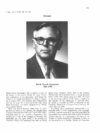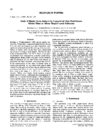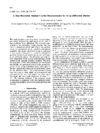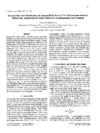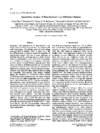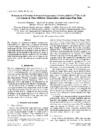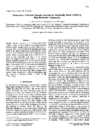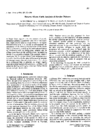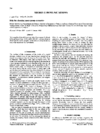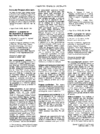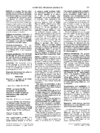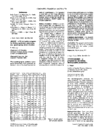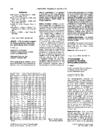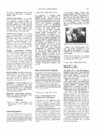issue contents
June 1996 issue

Cover illustration: Neutron scattering pattern in the (hk0) reciprocal-lattice plane from alpha-AgI at 520 K. The portion shown extends from 0 to 5.4 reciprocal-lattice units in both h and k. Courtesy of D. A. Keen, V. M. Nield and R. L. McGreevy.
obituaries
Free 

research papers
Biaxial stress in the system of 100 nm-thick cosputtered MoSi2 films on silicon substrates has been investigated by the use of a double-crystal X-ray diffractometer for curvature measurements, diffractometry and topography. Bending of the blank wafer increases the stress and must always be taken into account.
A new four-crystal monochromator system is presented. A beam divergence of 0.011 mrad and a wavelength dispersion of 4 × 10-5 are given as the best monochromator performances.
A set of Excel 4.0 macros is used to prepare and analyse protein crystallization experiments. A crystallization robot controlled by macros is also described.
Graph theory is employed to classify anomaly/peak bases in two-dimensional histograms from area-detector data.
Time-resolved Laue diffraction images obtained during relaxation of photoactive yellow protein from its photostationary state have been integrated by an analytical profile-fitting technique. Good-quality difference Fourier maps are obtained and the optimum strategies for data acquisition and analysis are identified.
A three-temperature diffraction experiment was carried out in order to clarify the adamantyl disorder in a small molecule. The disorder appears to be dynamical with an energy barrier that cannot be crossed below 150 K. Image-plate data were used throughout and provided an excellent data set for accurate refinement.
A synchrotron X-ray powder diffraction investigation of the β-to-γ and the γ-to-α phase transitions in KNO3 is presented.
A semi-automatic method, based on the recognition of conics by a plane-search algorithm in reciprocal space, is presented for the indexing of the Laue diffraction pattern.
Periodic domain inversion in an electric-field poled LiNbO3 crystal has been studied using high-resolution multiple-crystal multiple-reflection diffraction topography.
A reverse Monte Carlo algorithm for the analysis of powder diffraction data is presented, which models Bragg scattering as well as diffuse scattering.
teaching and education
Free 

The ACA'95 meeting was scheduled using a novel method for numerical minimization of conflicts between sessions, from the results of an e-mail poll of crystallographers about the session topics they most wished to attend. The meeting went pretty much according to the forecast from the poll, with just a few explainable surprises.
short communications
Ten examples of crystal structures are considered to show how the PARST program works when it compares atomic sets in the search for lost symmetries.
computer programs
The program represents the crystal structure and the corresponding powder pattern simultaneously. Translations and rotations of a preselected part of the asymmetric unit realize a simple manipulation of the structure.
computer program abstracts
A new version of MS-DOS program AXES for X-ray powder diffraction analysis is presented, including graphics facilities and dialogues for editing the initial data and parameters necessary for the Rietveld program FULLPROF.
Optical activity in specified crystallographic directions, main refractive indices and other optical properties are calculated from crystal data using a dipole–dipole interaction model.
A system for various crystal structure geometry calculations with some new measures of the regularity of atomic coordinations is presented.
A PC program is presented that makes space-group determination convenient and systematic.
A software package for PCs is presented that calculates and plots stereograms for arbitrary orientations.
crystallographers
Free 

new commercial products
Free 



 journal menu
journal menu









